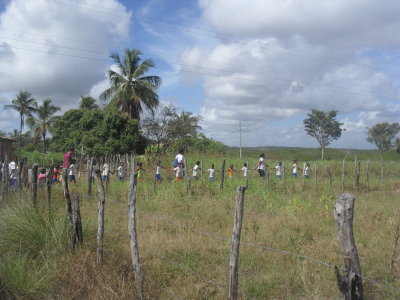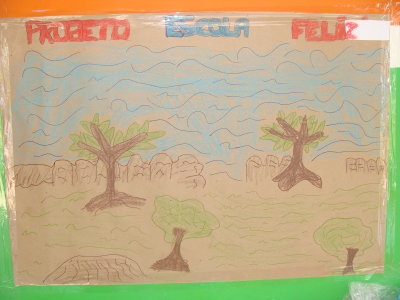Municipal School Valdemar Fontes Cardoso, Itaporanga, Sergipe State, Brazil
1.The school / group
Full name: Municipal School Valdemar Fontes Cardoso Type of school: Childhood and ElementaryIs the school public or private? Public
Type of school: Childhood and ElementaryIs the school public or private? Public
Location: City of Itaporanga - Island Community Mem de Sá - Estado de Sergipe - Brazil
Name of the Director: Angela Maria Nascimento dos Santos
How many pupils are there (girls / boys - teaching mixed)? Mixed classes (45 pupils - 4 to 13 years) and 20 pupils (special programme for the eradication of child labour: 13 - 17 years)
Are pupils mainly from the same city? Yes
How many teachers are there? two
Type of education (technical, scientific, artistic, ...)? School of formal education
Does the school offer science classes (theoretical, experimental, practical)? Theoretical Yes.
Does the school offer classes in arts (music, visual arts, art history, dance, visual arts, theater, ...)? No.
Does the school offer classes in various sports? No.
Can most / all pupils attend school regularly? Yes
 Other general information: The school is attended by children of fishermen and artisanal fishers (fish, crustaceans, molluscs), who themselves had no access to school (73 families with 360 people across the community). Children are encouraged to go to school because of the Family Grant Programme and school meals.
Other general information: The school is attended by children of fishermen and artisanal fishers (fish, crustaceans, molluscs), who themselves had no access to school (73 families with 360 people across the community). Children are encouraged to go to school because of the Family Grant Programme and school meals.
2.The socio-economic context of the school
Economic activities in the main area from where the pupils come to school: Only fishing.
Changes to these activities and context in the recent past, if any? The crab farming has led to deforestation of a small area in the island community (in 2000). The carcinocultura was later abandoned and is slowly rebuilding. A general indication of socio-economic levels: Monthly family income: RS 510.00 (including government subsidies and income from fishing).
Are families sedentary or are members of a family away for extended periods of time? Sedentary.
The school has well equipped facilities, library, electricity, running water, toilets, ...?
Library - no
Electricity - yes
Running water - no. The school has access to well water in the rainy season, but faces problems with supply in the dry season (eight months).
Is there a committee formed by parents, which supports and interacts with the school? Yes Island Community Association Mem de Sá.
Does the majority of pupils reach academic goals? Yes, because the system currently in place provides the student a passing grade, even if they present a very low academic performance.
Are there are opportunities for private study or otherwise broaden the pupils' work? Only with the good will of teachers and parents.
Does the school sponsor extracurricular activities or special school projects? No. In 2010, the Federal University of Sergipe (UFS), through the commitment of a Fisheries Extension Professor, Ms. Ana Rosa Araujo, developed activities with the school for four days, which included: recycling, community gardening, personal hygiene, community and productive activities, women's work, physical education.
Is there collaboration with government, businesses or nongovernmental organisations (NGOs)? No, only the initiative of the UFS.
3. School activities relevant to their participation in this initiative
Names of Instructors involved with work associated with this initiative: Prof. Ana Rosa Araújo - Professor, Federal University of Sergipe and coordinator of the event held in the community Mem de Sá.
Prof. Maria de Fátima Cardoso Santos - School teacher Municipal School Valdemar Fontes Cardoso
Prof. Joseilda dos Santos - School teacher Municipal School Valdemar Fontes Cardoso
Prof. Kátia de Meirelles Felizola Freire - Professor, Federal University of Sergipe and responsible for organising the material produced for the exhibition of Mundus maris.
Monitors: 10 students of the Fisheries Extension undergraduate degree in Fishing Engineering, Federal University of Sergipe.
Is the work within the curriculum or extra-curricular? Extra-curricular
Has the school participated already in earlier Mundus maris activities? Not yet.
Can teachers support their work through collaboration? Yes, other schools contributed material, toothbrushes donated by the State Health Department, the university released material (paper, pens), and students of the discipline also made donations.
Is networking recognized by the director / educational authority or it occurs without formal recognition? Yes, the work was recognised by the director, who is one of two school teachers.
What should be improved through cooperation? Better school planning, with teachers' training programme, improvement of school infrastructure in order to optimise children's learning, including improved water supply and an infrastructure for use by students, including area with tables and chairs, and better variety of school meals, including fresh fruits and foods with less salt; control problems with hypertension (found among adults).
Did you observe an effect of collaboration outside of school? As the initiative is very recent (November 2010), we are still unable to check out-of-school effects.What is the feedback from teachers / students / parents? Teachers requested to plan activities for the second half of 2011.
Aspirations for the next 12 to 24 months:
Discussion of planning for the next event, including more interaction with teachers that the school must meet local demands. Intention is to work with storytelling related to the environment, development of healthy eating, physical activity, processing of fish.
Date of your profile: November 2010.
Other comments:
We draw attention to the fact that the pupils did not depict the sea as part of the environment in which they live. Moreover, the mango tree is abundant in the region and always depicted in the drawings. It seems that for the children the mango tree is more important than the sea, which appears as more of a work environment to them.








